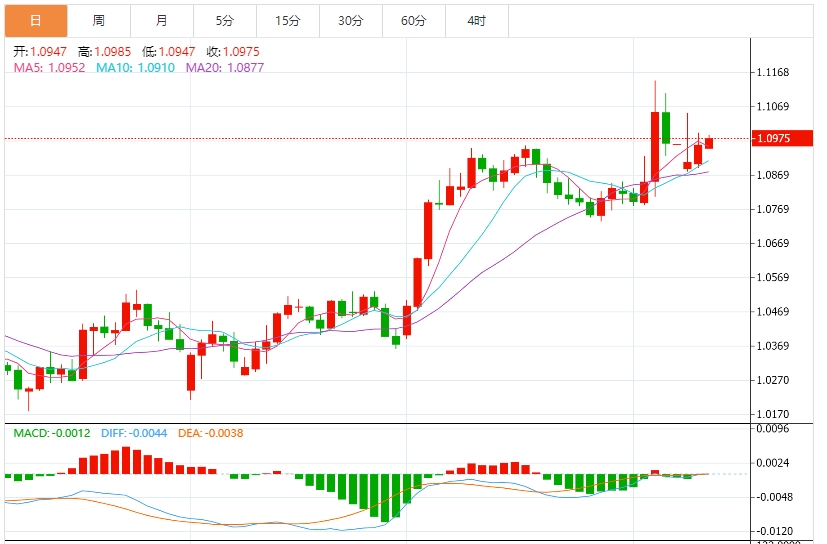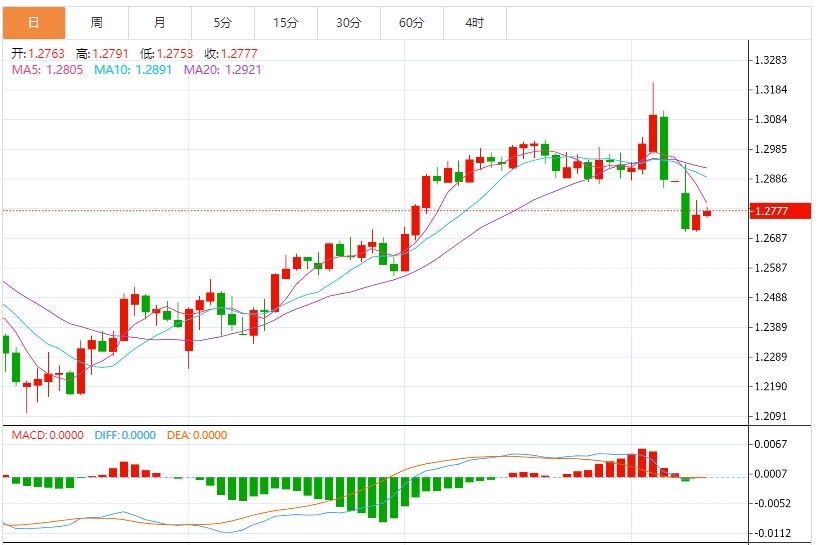In the Asian session on Wednesday, the US dollar index hovered around 102.56. Although the weaker dollar and trade tensions provided safe-haven support for gold, concerns about weak demand for US Treasury auctions, the Fed's policy outlook and increased stock market volatility still dominated short-term sentiment. Investors need to focus on the results of today's US 10-year Treasury auction, the minutes of the Fed's March meeting, and the quarterly earnings period opened by JPMorgan Chase and other financial reports.
US dollar: As of press time, the US dollar index hovered around 102.56, and the US dollar index (DXY) was trading around 103.00. The index tracks the performance of the US dollar (USD) against six major currencies after some comments from US Treasury Secretary Scott Bessent. In the past few days, the overall risk aversion sentiment has caused the US dollar to depreciate significantly, but DXY has begun to recover since the release of strong non-farm payrolls (NFP) data last Friday. The question is whether the index can maintain this recovery when more US data is released. Technically, the first level to watch is 103.18, above which a daily close must be seen. Above this level, the 104.00 round number mark and the 200-day simple moving average (SMA) at 104.86 will come into focus. On the downside, 101.90 is the first line of defense and should be able to trigger a rebound as it has held support for the past two trading sessions.

Euro: At press time, EUR/USD was hovering around 1.0975, up 0.17% on the day. EUR/USD recovered slightly on Tuesday, ending two days of losses and recording some last-minute gains before the Trump administration's broad "reciprocal" tariffs take effect on April 9. Fed rhetoric from key policymakers is beginning to clash with rising market expectations of Fed rate cuts through the rest of 2025, exposing the market to the negative impact of widespread tariffs. Technically, the outlook remains cautiously optimistic. The relative strength index (RSI) shows a neutral 58.60, while the moving average convergence/divergence (MACD) is biased bearish and signals a sell signal. Meanwhile, the Commodity Channel Index (CCI) at 73.12 and the Stochastic RSI fast indicator at 35.32 both remain neutral, showing a lack of clear directional momentum at the moment. However, strength is reflected in the moving averages. The 20-day simple moving average (SMA) at 1.08646, the 100-day SMA at 1.05377, and the 200-day SMA at 1.07364 are all pointing upwards, reflecting broad underlying support. Similarly, the 10-day exponential moving average (EMA) and 10-day SMA are hovering around 1.08880 and 1.08662, respectively, providing additional short-term bullish signals.

GBP: As of press time, GBP/USD hovered around 1.2789. GBP/USD ended a severe two-day downtrend on Tuesday, finding a technical rebound from the 200-day exponential moving average (EMA) just above 1.2700. Price action remains in no man's land ahead of the planned US tariffs, and investors await key US inflation and sentiment data to be released later this week. Overall, the UK economic data schedule is relatively light this week, and Tuesday's situation is a welcome relief from the geopolitical and trade headlines that have been normalized by the Trump administration in recent times. However, several key policymakers from the Federal Reserve (Fed) took the opportunity to speak out, warning that uncertainty and the adverse inflationary impact of US tariffs will make it more difficult, not easier, for the Fed to start cutting interest rates. Technically, GBP/USD saw a bullish breakout on Tuesday, finding a weak bounce from the 200-day EMA just above 1.2700. Bullish momentum remains marginally weak, but buying pressure was just enough to end a two-day downtrend during which GBP/USD fell more than 3% from high to low. Buyers still need to extend from the 200-day EMA to confirm a bullish recovery, but short-term momentum seems to be fading too quickly to allow for new sell positions.

The U.S. Treasury yield curve hit its steepest level since February 2022 on Tuesday, as longer-term Treasury yields jumped due to supply concerns, and some Treasury holders were also believed to be forced to sell due to recent market volatility. The intensifying trade war has also raised concerns about slowing economic growth, which has caused shorter-term bond yields to fall during the day. The curve between the two-year and 10-year Treasury yields steepened significantly, reaching 57 basis points, as the yields of the two maturities moved in opposite directions in a sharp fluctuation. Kim Rupert, managing director of Action Economics, said: "There will be a 10-year Treasury auction tomorrow, so I think this puts some pressure on the market."
Pharmaceutical companies warned European Commission President von der Leyen that they might move to the United States as tariffs are imminent, an industry group said after a meeting on Tuesday. "From capital availability, intellectual property, approval speed to innovation incentives, the United States is now ahead of Europe on all investor indicators," the European Federation of Pharmaceutical Industries and Associations (EFPIA) said in an emailed statement. "Now, with tariffs increasing, there is little incentive to invest in the EU, and there is a lot of incentive to move to the United States." According to the trade group's survey of 18 multinational companies, up to 85% of capital expenditure investments and up to half of research and development spending are at risk. This will translate into 103.2 billion euros ($112.9 billion). Drugmakers are asking the EU to "radically change its policies," including stronger intellectual property provisions and a coherent policy on environmental and chemical legislation. EFPIA represents about 40 pharmaceutical companies operating in Europe, including Bayer, AstraZeneca and Novartis.
Oregon Senator Ron Wyden said he would propose a new bipartisan bill to "end a new round of global tariffs that hit American families and businesses." Wyden, the Democratic leader of the Senate Finance Committee, did not disclose how many Republicans signed his bill. "Members of both parties know that this is a call for action, and Congress must step in to constrain the president on trade issues," Wyden said. At the trade hearing, Wyden condemned Trump's "aimless, chaotic and disorderly tariff frenzy" and repeatedly questioned the real reason for the tariffs.
On Tuesday, British Chancellor of the Exchequer Reeves said she would meet with US Treasury Secretary Bessant "soon" as part of broader negotiations on a new economic partnership. Reeves said the British government is seeking to build a stronger trade relationship with the United States while also providing a stable environment for domestic households, businesses and investors. "As a government, all decisions we make will be based on the stability of our non-negotiable fiscal rules," she said. "Trade wars are not in anyone's interest. That's why we must remain pragmatic and cool-headed and reach the best deal with the United States that is in our national interest."
In a report, BlackRock said that the money market's expectations for multiple Fed rate cuts were too high, ignoring the risk of rising inflation. It said: "We prefer that the market price of the Fed cut interest rates 4 to 5 times this year, each by 25 basis points." BlackRock expects global borrowing costs to be higher than before the epidemic as the upcoming tariffs push up inflation. "We believe that the plan for a new wave of tariffs in the United States and the response of other countries reinforce that we will be in a world where interest rates and long-term bond yields remain higher than before the pandemic." Tariffs and loose fiscal policies in some parts of the world may push up inflation.
JPMorgan analysts said that as the economic costs caused by US tariffs rise, the European Central Bank will cut interest rates at the next four meetings. Analysts such as Greg Fuzesi said in a research report that the short-term blow to eurozone economic growth will be greater than previously expected, resulting in "very weak" growth in the next three quarters. They said: "What is important for the ECB is that inflation has returned to the target level, and any further shocks will bring the risk of inflation below the target level." "The global environment will be very difficult in the coming months." The ECB has cut interest rates six times since June last year. Four more rate cuts will bring the deposit rate to 1.5%, and JPMorgan Chase even believes that the risk of this forecast is biased to the downside. In another institutional survey last month, economists predicted that the benchmark interest rate would only fall to 2%.
Jefferies said in a research report that in the foreseeable future, if British interest rate expectations do not collapse and the economy does not deteriorate substantially, British domestic banks will continue to distribute more than one-tenth of their market value each year. Analyst Jonathan Pierce and partner Priya Rathod wrote that the industry is sensitive to macroeconomic events because it affects interest rates and growth forecasts, as shown by the sharp drop in stock prices since US President Trump announced tariffs. Analysts say British banks are still in a good position because structural hedges provide a huge boost. Structural hedging is to mitigate the impact of interest rate changes. They said that in addition, they also believe that loans will not grow significantly and credit risks are not large. "Overall, we are not very worried at the moment."
Matthew Ryan, an analyst at Ebury, said in a report that the pound's recent underperformance may not continue because the Bank of England is likely to respond cautiously to US tariffs. "We expect the Bank of England will not overreact to tariffs, and the impact on the economy may be relatively small." The low 10% tariff imposed by the United States on British goods, coupled with the UK's limited exposure to global demand, makes the UK relatively unaffected. The pound has fallen due to risk aversion and the Bank of England's room to cut interest rates more significantly than other countries.